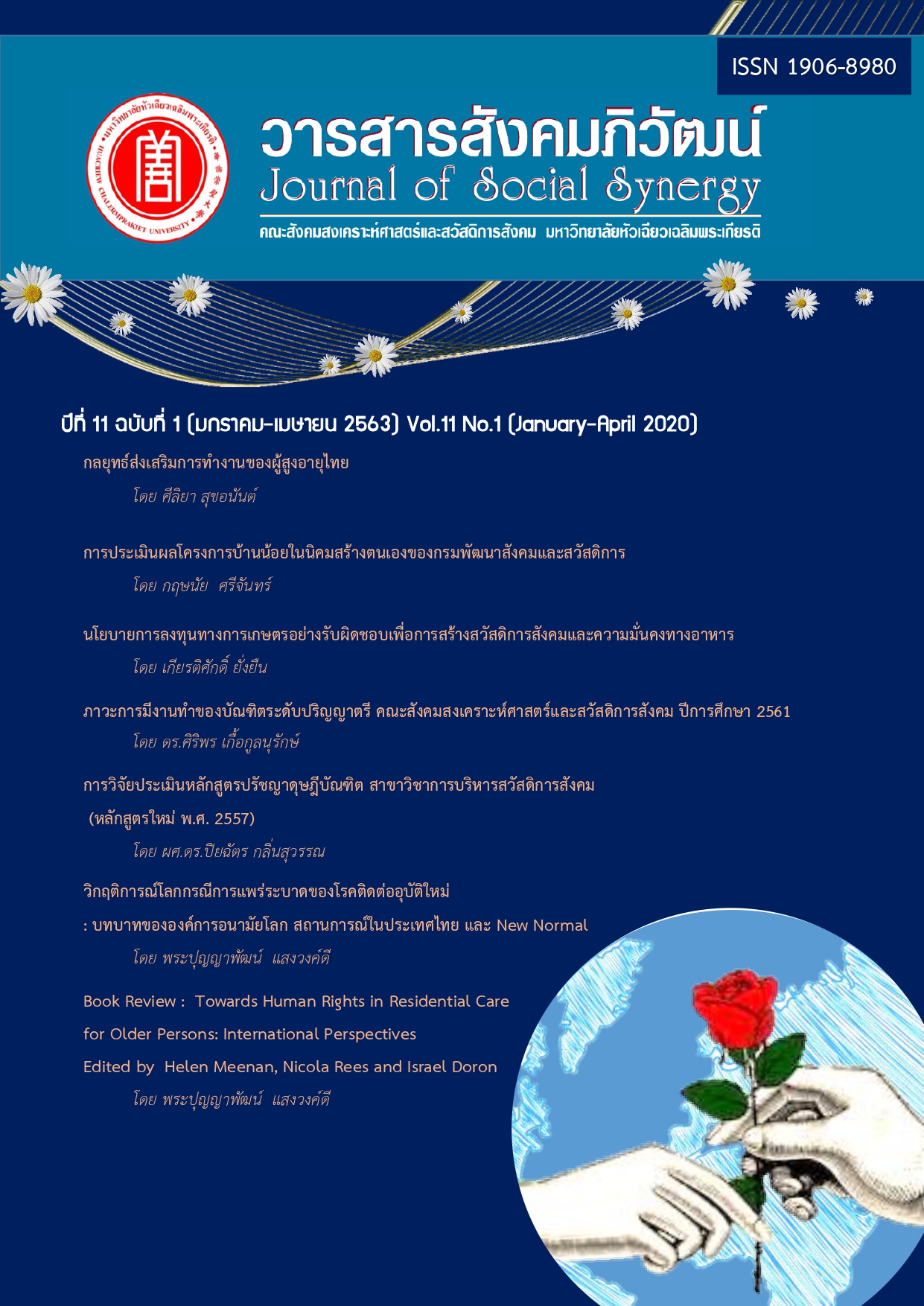Evaluation of the Ph.D. curriculum in Social Welfare Administration
Evaluation of the Ph.D. curriculum in Social Welfare Administration
Keywords:
Curriculum evaluation, Ph.D. Curriculum, CIPPIEST ModelAbstract
The purpose of this research was to evaluate the Ph.D. curriculum in Social Welfare Administration, Faculty of Social Work and Social Welfare, Huachiew Chalermprakiet University (HCU), Thailand. The researcher collected data from documents, interviews, questionnaires, rating scales and used the CIPPIEST Model in the evaluation process. The data was analyzed by using data frequency, percentage, mean, standard deviation, correlation coefficient and content analysis. The research revealed that: the evaluation of the curriculum’s context, input, process, product, impact, effectiveness, sustainability, and transportability are appropriate at the “high” level.
The best comments and suggestions regarding the research on the Ph.D. Curriculum were 1) The objective structure and content of the curriculum is outstanding 2) Many of the students were highly experienced and 22% received The Royal Golden Jubilee Ph.D. Program while two HCU’s students in the Ph.D. curriculum in Social Welfare Administration were rewarded “best of writing journal” 3) There was a unity in planning and executing the curriculum development and maintained the quality of the curriculum 4) There should be minor changes and development in the current curriculum in an effort to cope with the digital era 5) A network of academic collaboration between universities should be established 6) The campus should see more improvement in research facilities and learning resources in order to strengthen the curriculum 7) Certain basic infrastructures and overall conditions of academic services should be further developed
References
กระทรวงศึกษาธิการ. (2552). ประกาศกระทรวงศึกษาธิการเรื่อง กรอบมาตรฐานคุณวุฒิระดับอุดมศึกษา แห่งชาติ พ.ศ. 2552. สืบค้น 28 กันยายน 2561, จาก http://www.mua.go.th/users/tqf-hed/news/FilesNews2/news2.pdf
พรทิพย์ ไชยโส, วสันต์ ทองไทย, และแม้นมาศ ลีลสัตยกุล (2559). การประเมินหลักสูตรปรัชญาดุษฎีบัณฑิต สาขาวิชาวิทยาศาสตร์ศึกษา หลักสูตร 5 ปี. ใน การประชุมทางวิชาการของมหาวิทยาลัยเกษตรศาสตร์ ครั้งที่ 46: สาขาศึกษาศาสตร์ สาขามนุษยศาสตร์และสังคมศาสตร์ สาขาเศรษฐศาสตร์และบริหารธุรกิจ สาขาส่งเสริมการเกษตรและคหกรรมศาสตร์ (น.89-96). กรุงเทพฯ: มหาวิทยาลัยเกษตรศาสตร์.
ภารดี อนันต์นาวี. (2558). การประเมินหลักสูตรปรัชญาดุษฎีบัณฑิต สาขาวิชาการบริหารการศึกษา ฉบับ ปรับปรุง พ.ศ. 2554. วารสารบริหารการศึกษา มศว, 12(23), 98-107.
มัทนา วังถนอมศักดิ์. (2554). การประเมินหลักสูตรปรัชญาดุษฎีบัณฑิต สาขาวิชาการบริหารการศึกษาคณะศึกษาศาสตร์ มหาวิทยาลัยศิลปากร. วารสารศิลปากรศึกษาศาสตร์วิจัย, 3(1,2), 38-49.
มาเรียม นิลพันธุ์. (2554). การประเมินหลักสูตรปรัชญาดุษฎีบัณฑิต สาขาวิชาหลักสูตรและการสอน คณะศึกษาศาสตร์ มหาวิทยาลัยศิลปากร. วารสารวิชาการVeridian E –Journal,Silpakorn University, 4(2), 248-262.
ราชกิจจานุเบกษา. (2558). ประกาศกระทรวงศึกษาธิการ เรื่อง มาตรฐานหลักสูตรระดับอุดมศึกษา พ.ศ. 2558 และเกณฑ์มาตรฐานที่เกี่ยวข้อง เล่มที่ 132 ตนพิเศษ 295 ง ลงวันที่ 13 พฤศจิกายน 2558 หน้า 40.สืบค้น 23 มิถุนายน 2561, จาก http://www.mua.go.th/users/he-commission/doc/law/ohec%20law/2558%20gradu%202558.PDF
ศิริณา จิตต์จรัส, คีรีบูน จงวุฒิเวศย์, และพรรณภัทร ปลังศรีเจริญสุข. (2556). การประเมินผลหลักสูตรศึกษาศาสตรดุษฎีบัณฑิต สาขาวิชาการศึกษาตลอดชีวิตและการพัฒนามนุษย์. วารสารศึกษาศาสตร์ มหาวิทยาลัยศิลปากร, 9(2), 98-114.
Bilbao, P. P., Lucido, P. I., Iringan, T. C., and R. B. Javier (2008). Curriculum development. Philippines: Lorimar Publishing.
Brydon-Miller, M. (2001). Education, research, and action: Theory and methods of participatory action research. In D.L. Tolman & M. Brydon-Miller (Eds.), From subjects to subjectivities: A handbook of interpretive and participatory methods. New York: New York University Press.
Cronbach, L.J. (1970). Course improvement through evaluation. Teachers College Record, 64(8), 672 - 683.
Hammond, R. (1969). Context Evaluation of instruction in Local School Districts. Educational Technology, 9(1), 13 –18.
Kirkpatrick, D. L., & Kirkpatrick, J. D. (2006). Evaluating training programs: The four levels. (3rd ed.). San Francisco: Barrett-Koehler.
Likert, R. (1932). A technique for the measurement of attitudes. New York: The Science Press.
Provus, M. (1971). Discrepancy evaluation for educational program improvement and assessment. California: Mc Cutchan.
Scriven, M. (1967). The methodology of Evaluation, in: R. Tyler, R. Gagné & M. Scriven (Eds.), Perspectives of curriculum evaluation (AERA monograph series on curriculum evaluation, No. 1) Chicago: Rand McNally.
Stufflebeam, D. L. (2003). The CIPP model for evaluation. In Stufflebeam, D. L. & Kellaghan, T. (Eds.), The international handbook of educational evaluation (Chapter 2). Boston: Kluwer Academic Publishers.
Stufflebeam, D. L., & Shinkfield, A. J. (2007). Evaluation theory, models and applications. California: Jossey-Bass.
Tyler, R. W. (1954). Basic principles of curriculum and instruction. Chicago: The University of Chicago Press.
Downloads
Published
How to Cite
Issue
Section
License
บทความที่ได้รับการตีพิมพ์เป็นลิขสิทธิ์ของวารสารสังคมภิวัฒน์ มหาวิทยาลัยหัวเฉียวเฉลิมพระเกียรติ
ข้อความที่ปรากฏในบทความแต่ละเรื่องในวารสารวิชาการเล่มนี้เป็นความคิดเห็นส่วนตัวของผู้เขียนแต่ละท่านไม่เกี่ยวข้องกับมหาวิทยาลัยหัวเฉียวเฉลิมพระเกียรติ และคณาจารย์ท่านอื่นๆในมหาวิทยาลัยฯ แต่อย่างใด ความรับผิดชอบองค์ประกอบทั้งหมดของบทความแต่ละเรื่องเป็นของผู้เขียนแต่ละท่าน หากมีความผิดพลาดใดๆ ผู้เขียนแต่ละท่านจะรับผิดชอบบทความของตนเองแต่ผู้เดียว




